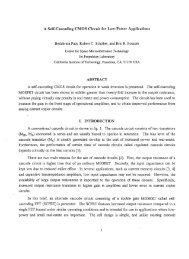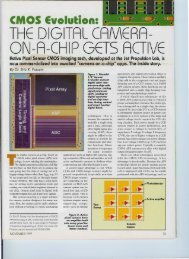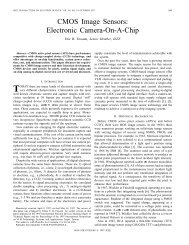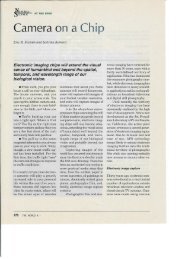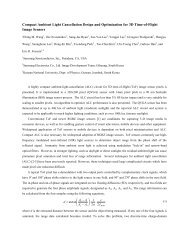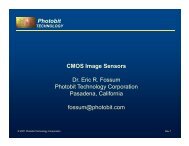Infrared readout electronics for space science sensors - Eric Fossum
Infrared readout electronics for space science sensors - Eric Fossum
Infrared readout electronics for space science sensors - Eric Fossum
Create successful ePaper yourself
Turn your PDF publications into a flip-book with our unique Google optimized e-Paper software.
with A0 being the amplifier gain. As a result of the feedback, the effective saturation frequency of CTIA is decreasedcompared to that of SFD, and is given by:satC +C2voRo[Cint + ivod JCTIA is used <strong>for</strong> low noise, large bandwidth applications since the smallest integration time is limited by the unity gainfrequency of the amplifier. However, there is a trade-off between operating with a small integration time and focal-planepower dissipation.Ignoring the reset noise and the downstream noise (small <strong>for</strong> a low value of integration capacitance), the input-referrednoise electrons of CTIA is given by:KN2)white+ [Cjflt+CdCL +Ci+Cd]Cint +2T2 mt1KN2) 1/f q2 Sfdli{ sat"7int a "5)f)2lnhIIll.8fawhere Sfa is the amplifier 1/f noise drain current power spectral density at 1 Hz, a is the cutoff frequency of the amplifier,and typically limits the shortest integration time. CTIA input-referred noise is independent of amplifier gain, providedthe gain is large. The input-referred noise can be made small by making the integration capacitance small, whileincreasing the load capacitance at the same time to decrease the amplifier noise by reducing the noise bandwidth. Fig. 8indicates that CTIA white noise per<strong>for</strong>mance is slightly inferior to that of GMI <strong>for</strong> a given capacitance. However, GMIintegration capacitance cannot be made very small in practice because of the limitations imposed by bus charge sharing,while CTIA integration capacitance can be made as small as 1 fF, leading to ultra low noise per<strong>for</strong>mance.CTIA unit cells have been applied in a wide variety of circumstances and both in staring and in scanning modes. In earlyef<strong>for</strong>ts, 10 electron read noise was reported by Rockwell and Amber using a CTIA unit cell that was operated at 92 K [25J.Honeywell reported obtaining 70 electron read noise using CTIA unit cell and integration times as high as 100 seconds[26] <strong>for</strong> SWIR applications. With further advancements in IR detector technology, some of the lowest noise per<strong>for</strong>mancehave been achieved with CTIA as the <strong>readout</strong> unit cell, especially by incorporating a unit cell CDS circuit.Rockwell has demonstrated a SWIR JR FPA with an ultra low noise CTIA-CDS unit cell operated at very lowbackgrounds (< 106 photons/cm2/sec) in 1282 <strong>for</strong>mat 1101. The CTIA was biased at subthreshold in order to reducepower. With a 4 IF integration capacitance, 23 fF detector capacitance, 1.5 pF load capacitance, and a nominalintegration time of 20 msec., the read noise was measured to be 3.4 electrons. Rockwell has also demonstrated a highper<strong>for</strong>mance SWIR lOx 132 scanning IR FPA with a "sidecar" architecture. The unit cell consists of CTIA and CDS, andthe "sidecar" TDI stage is implemented with a (10x3)x132 CCD. The unit cell dimensions are 25x75 m2, A novelfeature of the CTIA is that no explicit integration capacitance was added to the unit cell. The integration capacitance274 / SPJE Vol. 2020 <strong>Infrared</strong> Technology XIX (1993)



